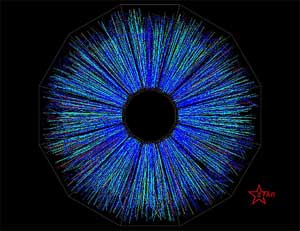 Two gold ions collide head-on in the STAR detector. (Photo from http://www.rhic.bnl.gov/STAR/) |
The RHIC facility is focused on the production and study of the quark-gluon plasma (QGP), a hypothetical hot, dense soup of single quarks and gluons last believed to exist naturally in the first millionth of a second after the Big Bang. By smashing together sufficiently dense bunches of heavy nuclei at sufficiently high energies, scientists expect that the nuclei will dissolve into a similar soup of free quarks and gluons, yielding valuable insights into the early universe, as well as the matter we observe today.
Previous accelerator facilities have not been able to create a verifiable QGP because they cannot attain the high energies required, although recent experimental results at CERN have provided signs of an exotic form of nuclear matter that might be a QGP. However, "Discovering the QGP will be like a murder trial without a smoking gun," says Xin-Nian Wang of Lawrence Berkeley Laboratory. "It has to be a conviction beyond a reasonable doubt. We have to convince ourselves that the signals we see are caused only by the formation of the QGP and nothing else."
Producing collisions 10 times more powerful than those at CERN, the RHIC facility currently boasts four advanced detectors - BRAHMS, PHENIX, PHOBOS and STAR - for the study of particles produced by the collisions. The eventual goal is to achieve energies of 100 GeV per nucleon in each of the two heavy-ion beams. "By means of extraordinarily high energy nuclear collisions, RHIC will act as a giant pressure cooker, producing temperatures and particle densities tens of thousands of times greater than exist now even at the center of stars," says Brookhaven physicist Tom Ludlam.
In addition to creating the QGP, other research goals for the RHIC facility include colliding protons at high energies to make what should be the first definitive measurement of the contribution of gluons to the proton's spin. Researchers also plan to search for violations of such fundamental physics symmetries as parity and charge-parity that would occur because of the strong nuclear force. (In contrast, previously the non-conservation of P and CP have come about only because of the weak nuclear force.)
-Reported by Inside Science news team
©1995 - 2024, AMERICAN PHYSICAL SOCIETY
APS encourages the redistribution of the materials included in this newspaper provided that attribution to the source is noted and the materials are not truncated or changed.
Associate Editor: Jennifer Ouellette
August/September 2000 (Volume 9, Number 8)
Articles in this Issue

